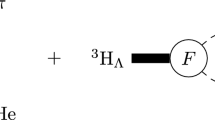Summary
A phenomenological theory of nonleptonic hyperon decays is proposed which does not rely on octet dominance and onR orRP invariance. PostulatingSU 3 symmetry and a certain space-time behavior, a minimalH wis uniquely obtained. AllS- andP-wave amplitudes are computed and expressed in terms of five parameters. Experimentally correct relations are deduced.
Riassunto
Si propone una teoria fenomenologica dei decadimenti non leptonici degli iperoni, che non si basa sulla predominanza dell'ottetto e sull'invarianzaR oRP. Postulando la simmetriaSU 3 e un certo comportamento dello spazio-tempo, si ottiene, univocamente unH wminimo. Si calcolano tutte le ampiezze in ondaS eP e le si esprime in funzione di cinque parametri. Si deducono relazioni sperimentalmente corrette.
Similar content being viewed by others
References
For a review, see for example,R. H. Dalitz:Proc. S.I.F., Course XXXII (New York, London, 1966).
M. Gell-Mann:Phys. Rev. Lett.,12, 155 (1964).
H. Sugawara:Progr. Theor. Phys.,31, 213 (1964).
B. W. Lee:Phys. Rev. Lett.,12, 83 (1964).
M. L. Stevenson, J. P. Berge, J. R. Hubbard, G. R. Kalbfleisch, J. B. Schafer, F. T. Solmitz, S. G. Wojcicki andP. G. Wohlmut:Phys. Lett.,9, 349 (1964).
It should be mentioned, though, thatS. Coleman andS. L. Glashow:Phys Rev.,134, B 671 (1964), obtained these relations on the basis of broken vacuum symmetry arguments.
T. D. Lee:Phys. Rev.,140, B 959 (1965).
B. W. Lee andA. R. Swift:Phys. Rev.,136, B 228 (1964).
J. J. de Swart:Rev. Mod. Phys.,35, 916 (1963).
The necessity of having both 8 and 10 is obvious, but it could be argued that the 10* just repeats the contribution of 8. However, as we shall see below, the presence of 10* is necessitated by the requirement of T. D. Lee's space-time invariances.
From the current-current viewpoint, it seems plausible that the 27 should be included. It would contribute ΔI=3/2, ΔI z=−1/2, ΔY=1, like the 10, and aslo ΔI=1/2, ΔI z=−1/2, ΔY=1, like the 8 and 10*.
Concerning our notation, it should be kept in mind that a certainT ±i refers to an entireSU 3 multiplet of terms, even though when we actually calculate a certain matrix element later on, we retain only the particular members of the multiplet which yield nonvanishing contributions.
Note, however, that no true «particles» are assigned to ourH wso that all that we deal with is a tensor as a whole, with certainSU 3 transformation laws.
P. McNamee andF. Chilton:Rev. Mod. Phys.,36, 1005 (1964).
Same applies to |K −〉, but this is irrelevant for us.
Note that even if the same subscriptν 2 is given to eachT i,it is to be understood thatν 2 depends onμ 2 of the particular term. Cf. Table I.
See, for example, ref. (5)M. L. Stevenson, J. P. Berge, J. R. Hubbard, G. R. Kalbfleisch, J. B. Schafer., F. T. Solmitz, S. G. Wojcicki andP. G. Wohlmut:Phys. Lett.,9, 349 (1964).
Since we shall considerS- andP-wave amplitudes separately, the suppression of the constant—ε in eq. (2) is without consequence.
A. H. Rosenfeld, A. Barbaro-Galtieri, W. H. Barkas, P. L. Bastien, J. Kirz andM. Roos Rev. Mod. Phys.,37, 633 (1965).
Note that there does not exist such a decomposition for theH 1 term.
T. Das andK. T. Mahanthappa: University of Pennsylvania Preprint, August 1965.
We also recall that in the standard theory of leptonic weak decays, two solutions are obtained for (D/F)ax,viz., 1.68 and 0.51, cf. ref. (1). The first gives the correct branching ratios and the second is rejected. It is amusing to note that this second solution agrees well (apart from sign) with the value of ref. (21)T. Das andK. T. Mahanthappa: University of Pennsylvania Preprint, August 1965 and our present prediction.
Author information
Authors and Affiliations
Additional information
Research sponsored by the U. S. Air Force under Grant No. AF-AFOSR-385-65.
Traduzione a cura della Redazione.
Rights and permissions
About this article
Cite this article
Roman, P., Yun, S.K. A novel approach to nonleptonic weak hyperon decays. Nuovo Cimento A (1965-1970) 44, 1091–1109 (1966). https://doi.org/10.1007/BF02719352
Received:
Published:
Issue Date:
DOI: https://doi.org/10.1007/BF02719352



